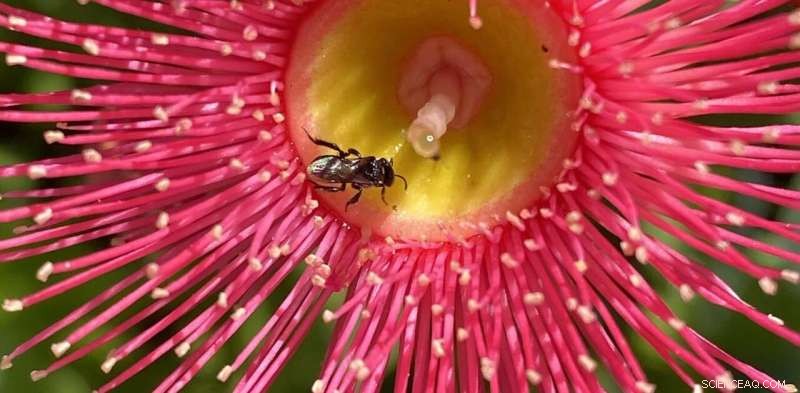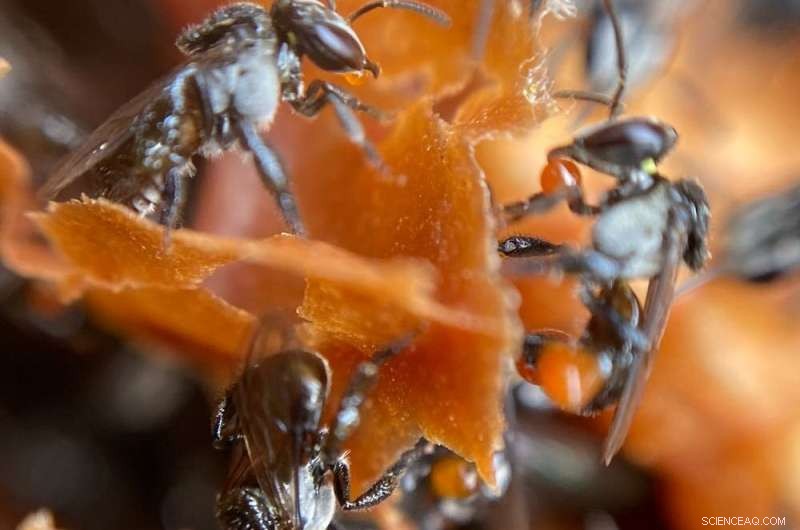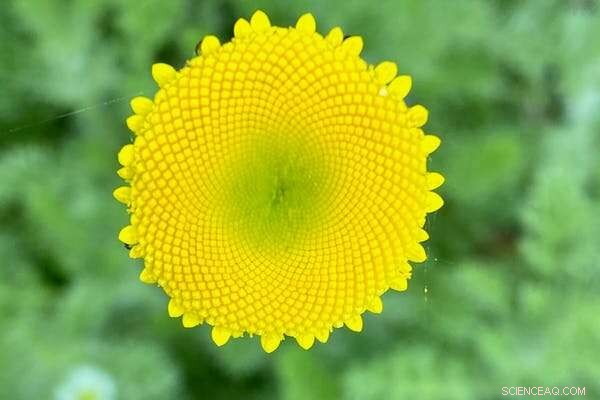
Credito:Judy Friedlander, Autore fornito
La tassonomia era un tempo dominio di scienziati in camice bianco con anni di formazione universitaria. Sebbene questa esperienza sia ancora importante, gli australiani di tutti i giorni stanno aiutando sempre più a identificare le specie attraverso le app di citizen science. I rapidi progressi nelle fotocamere di smartphone e tablet stanno contribuendo a rendere popolare questa attività.
I ricercatori sulla biodiversità chiedono ai cittadini scienziati di fornire dati per colmare le lacune informative, identificare il declino delle specie e informare le decisioni di gestione. E i giovani ricercatori, alcuni piccoli come i bambini delle scuole materne, si stanno facendo avanti per aiutare.
Storie come l'esperienza del quattordicenne Luke Downey, di Canberra, ispirano gli altri a registrare e caricare immagini nei database della biodiversità. All'inizio di quest'anno, Luke ha trovato uno scarabeo raro, Castiarina testaceo , visto l'ultima volta nell'ACT nel 1955. La sua osservazione è stata registrata nella Canberra Nature Map, un archivio online di piante e animali rari.
Teen trova un raro scarabeo gioiello a LBG 65 anni dopo il primo avvistamento ACT https://t.co/EqPT0P9I5O tramite @canberratimes
— Dramatis Scientificae (@DramSci) 11 gennaio 2021
Ho messo un obiettivo macro sul mio smartphone e ne sono rimasto affascinato
La mia ispirazione per diventare uno scienziato cittadino è stata un obiettivo macro economico ora fissato in modo permanente sul mio smartphone. Questo piccolo obiettivo portatile fotografa piccoli soggetti a distanze molto ravvicinate. (Alcuni smartphone più recenti hanno obiettivi integrati che possono farlo.)
Ho colto il "bug" di scattare immagini dettagliate in primo piano come quella qui sotto di api autoctone senza pungiglione, Tetragonula carbonaria , comunicando tra loro e ammirando, o badando, alla loro cera d'api. Condividere le immagini che ho scattato ha convertito altri a questo tipo di scienza dei cittadini.

Collegando un obiettivo macro al tuo smartphone (alcuni hanno fotocamere ravvicinate integrate), puoi scattare foto come questa dell'ape nativa senza pungiglione, Tetragonula carbonaria. Credito:Judy Friedlander, Autore fornito
Chiunque ora può scattare primi piani di insetti, piante e altre specie per contribuire ai database della scienza dei cittadini. La chiarezza di queste immagini significa che gli esperti possono spesso determinare le specie, aumentando la comprensione della distribuzione e dei numeri per aiutare la conservazione sul terreno.
Attività come queste sono presenti nel programma B&B Highway, gestito da PlantingSeeds Projects. Il programma incoraggia gli studenti delle scuole del New South Wales e del Victoria a partecipare a un progetto di citizen science. È affiliato con la rete internazionale di biodiversità e database iNaturalist e Atlas of Living Australia di CSIRO.
Gli studenti utilizzano smartphone e tablet nei cortili delle scuole per catturare immagini straordinarie di insetti lunghi meno di 1 cm o piccoli dettagli di parti di fiori. There's an online dashboard where students can see and share observations and knowledge. These images then contribute to our knowledge of species distributions and densities.
Focusing on pollinators
The B&B Highway program has developed a biodiversity-based curriculum with the NSW Department of Education. The project includes plantings and constructed habitats at schools to form regenerative corridors. It has a target of over 60 hubs by mid-2022 to help counter the alarming decline in pollinators in Australia and around the world.
The B&B Highway program provides training for teachers and students. While students are often more at ease with smart devices and their camera functions than their teachers, separate instructions are given to school administrators to set up an iNaturalist account and upload observations. Having a school account ensures students' identities are protected and all observations are listed as the schools."
Children under the age of 13 cannot create an account or engage directly with many citizen science communities, including iNaturalist. This means an adult needs to upload observations.

The photos you take can help fill the gaps in knowledge about the distribution and abundance of pollinators and the flowers they visit. Credit:Judy Friedlander, Author provided
An observation is regarded as research grade if at least two site users agree on the identification to the taxonomic species level. Observations on iNaturalist are shared with the Atlas of Living Australia.
Taxonomists regularly report concern at the lack of data on the distributions and densities of insect pollinators. This month's addition of 124 Australian species to the International Union for Conservation of Nature's (IUCN) Red List of Threatened Species means urgent strategies—including citizen science—are needed to help regeneration.
Urban observations are important as about 30% of Australia's threatened species occur in cities. Yet only about 5% of citizen science projects in Australia are urban-based. With three-quarters of Australia's 23.4 million people now living in a capital city, the citizen science potential is enormous.
Some tips from the experts
The following tips drawn from the iNaturalist teacher's guide will help you get started.
Take identifiable photos. Try to fill the frame with your subject. It may help to use your hand to hold a flower or plant still, but make sure the plant is not dangerous.
Take multiple photos. Many organisms, particularly plants and insects, cannot be identified to species level from a single photo. Take several photos from different angles. For plants, photos of flowers, fruit and leaves are all helpful for ID.

Observations of wild species, like this King Parrot, Alisterus scapularis, are of more scientific value. Credito:Autore fornito
Focus on wild organisms. In general, the iNat community is more interested in wild organisms. Members respond more to pictures of weeds and bugs than cultivated roses and hamsters in cages.
Pay attention to metadata. This is the information associated with a photo that captures when and where (if location services are on) a photo was taken. Screen shots of photos will lose this data, which may result in incorrect data entry. Watch for locations and dates that don't make sense. If your device's time and date settings are wrong, the data will be wrong.
Don't feel pressured to make research grade observations . Many organisms cannot be identified to the species level using only photographic evidence so observations of them may never attain research grade.
Be aware of copyright. Images should not be copied from books or the internet to illustrate what you observed. Post only your own photos.
Check out Seek. Seek is an educational tool built on iNaturalist. It does not actually post observations to iNaturalist but provides tools such as automated species identification (when possible) and nature journalling.